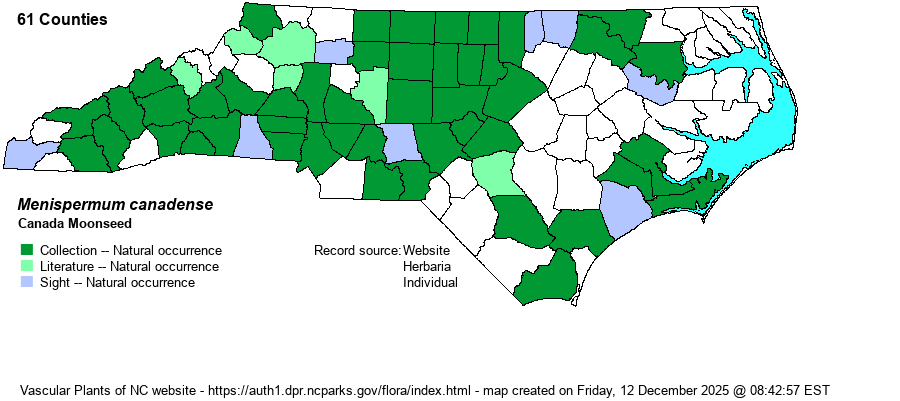| Author | L. | |
| Distribution | Essentially throughout the Mountains and Piedmont, and scattered over the Coastal Plain, being absent only from the far eastern counties. No records east of Bertie, Martin, Craven, and Carteret counties.
This is a widespread Eastern and Midwestern species, ranging from eastern Canada south to northern FL and central TX. It is found in nearly all counties in many states to the north and northwest of NC. | |
| Abundance | Fairly common to common across most of the Mountains and Piedmont, being generally common in the southern Mountains and the central and eastern Piedmont. Locally fairly common in the Coastal Plain along several brownwater rivers -- the Roanoke and Cape Fear -- but rare to uncommon in most areas in that province. Absent from the Sandhills proper. | |
| Habitat | This is a species of rich, often high pH soils, typically in bottomlands and other floodplain habitats. It does grow onto lower slopes, where the soils are quite moist and rich, but normally it grows within floodplains, often in light gaps and other openings. |
| Phenology | Blooms from June to August, and fruits shortly after flowering. | |
| Identification | This is a rather robust herbaceous vine, somewhat like a grape (Vitis spp.) in general appearance, though those species are woody vines. It grows to about 10 feet tall or high, climbing over other vegetation. The alternate leaves are distinctive; the petiole meets the blade not at the base but near it, thus is peltate. The blade is broadly ovate to orbicular, though has several shallow indentions such that the blade appears to have 5-7 shallow (often triangular) lobes, somewhat like a grape leaf but with entire margins. The blades are about 4-5 inches wide and about 4 inches long. The flowers are tiny and white to greenish, in drooping clusters in leaf axils or terminal. However, the drupes ("berries") are distinctive, being blue-black, shiny, and about 1/3-inch across, in dangling clusters. The species should be readily separated from any other species by its peltate leaves. | |
| Taxonomic Comments | None
| |
| Other Common Name(s) | Moonseed, Common Moonseed, Yellow Parilla | |
| State Rank | S4 [S5] | |
| Global Rank | G5 | |
| State Status | | |
| US Status | | |
| USACE-agcp | FACU link |
| USACE-emp | FACU link |

